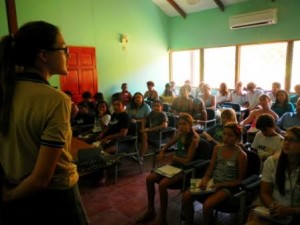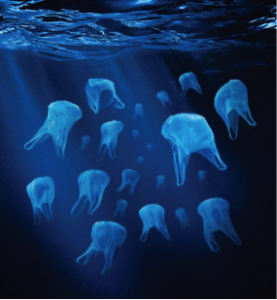By Shivani Kuckreja
COSTA RICA– Sitting in the midst of the sprawling Las Baulas National Park, Tera Corinne Dornfeld begins to detail the many plights of sea turtles. As her turtle tattoo may suggest, Tera has devoted the past decade of her life to studying the decline of sea turtle populations. Now, from her small, dimly-lit room in the middle of Costa Rica, she shares her findings and explains why she is hopeful for the future of the species.
Just last year, it was estimated that 17%-22% of marine life caught annually by fishermen is discarded. In Costa Rica, alone, 15,000 sea turtles are killed annually by shrimpers. While the statistics seem bleak, Tera has faith that turtle excluder devices, or TEDs, can help decrease the number of turtles killed as by-catch. Rather than have fishermen unintentionally catch and suffocate sea turtles in their shrimp trawls, TEDs include areas in which sea turtles can escape the trawling nets. Citing the work of Sally Murphy, Dornfeld explains that the clunky TEDs are being remodeled to better suit thus to better appeal to the preferences of fishermen.
She also sees TEDs as an opportunity for the local Costan Rican communities to get involved. By encouraging local fishermen to join the discussion and voice their concerns and input, TEDs can be better designed for the average Costa Rican fisherman hoping to catch fish and shrimp—not turtles.
Not all sea turtle struggles can be solved by TEDs, however. It is sad to think that “after a long day of dodging fishing nets and nesting threats, leatherback turtles are still in danger when they are doing the most basic acts of all—looking for food”, Dornfeld states in despair. Drawing from her primary focus on leatherback turtles, she explains that the turtle’s only source of food is jellyfish, which is why it is so important that global communities—and, more locally, Costa Rican residents—address the littering of plastic bags, which leatherback turtles often mistake for jellyfish.
Acknowledging the impracticality and complexity of banning plastic bags, Dornfeld explains that the culture of Costa Rica is such that plastic bags are necessary, as trash and septic services in her area require all residents to dispose of trash in plastic bags. Maintaining hope, however, she sees an opportunity to ban the use of straws in restaurants around Costa Rica. Straws can get lodged in the noses of sea turtles, interfering with their breathing. After witnessing the pain inflicted on a sea turtle when a team tries to remove a straw from a turtle’s nose, Dornfeld is motivated to join forces with local Costan Rican communities to pick that battle in the coming months.
In addition to the threats that sea turtles face from plastics, Dornfeld also anticipates significant impacts on sea turtle populations as a result of climate change. The sex of sea turtles depends entirely on the temperature of the sand on which the eggs are laid. Within the next century, temperatures are expected to rise between 2.5 degrees Fahrenheit and 10 degrees Fahrenheit, and warmer temperatures yield female sea turtles. Being a tropical area, Costa Rica is especially vulnerable to the impacts of climate change. By 2050, the country’s temperatures are expected to increase by 2 degrees Celsius; by 2100, 4 degrees Celsius.
In the short-term, the number of female sea turtles are expected to rise significantly, eventually leading to a drop in overall sea turtle populations due to the absence of male sea turtles. In extreme cases of increased temperatures or decreased rain, such as what may occur in Costa Rica, many sea turtles could die.
Costa Ricans were estimated to emit only 7 million metric tons of CO2 in 2012, in comparison to the 36 gigatonnes of global emissions in 2012, but it is Costa Rican communities that will experience the severity of climate change. For the sake of under-resourced areas like Costa Rica, that have low carbon dioxide (CO2) emissions yet bear a large burden of the affects of CO2 emissions, it is imperative that countries around the world, especially developed countries, work to decrease their climate change-causing emissions, as the responsibility should not fall exclusively upon Costa Rica and similar countries.
Decreases in global CO2 emissions are imperative because Costa Rica’s economy depends heavily on tourism. Since the early 2000s, travel and ecotourism in Costa Rica has decreased, originally contributing 6.5% of Costa Rica’s GDP but declining to 4.5% of Costa Rica’s GDP by 2014. At the same time, the leatherback sea turtle population within Costa Rica has declined by over 90% since 1980, and will only further decline as climate change continues to impact our planet.
While sea turtle populations are facing incredible setbacks today, Dornfeld remains encouraged by the fact that sea turtles are an umbrella species for conservation: “When you protect sea turtles, you are protecting all other plants and animals in and around the ocean.” For starters, green sea turtles’ grazing helps maintain sea grass beds, which serve as breeding grounds for many sea creatures including fish and crustaceans. Furthermore, the unhatched sea turtles along the nesting habitat provide nutrients to dune vegetation, and stronger dune vegetation helps protect the beach from erosion.
Focusing her efforts on the powers of small-scale sea turtle conservation projects, Dornfeld looks forward to working with local communities to help ensure that sea turtles get back up on their flippers. She is also interested in learning more about how women can take time away from performing the traditional duties of a housewife to become involved in these small-scale projects. “What is possible to achieve through social science?” she asks, time and again throughout our conversation. “What needs to happen for people to drop everything and help the sea turtles?”


